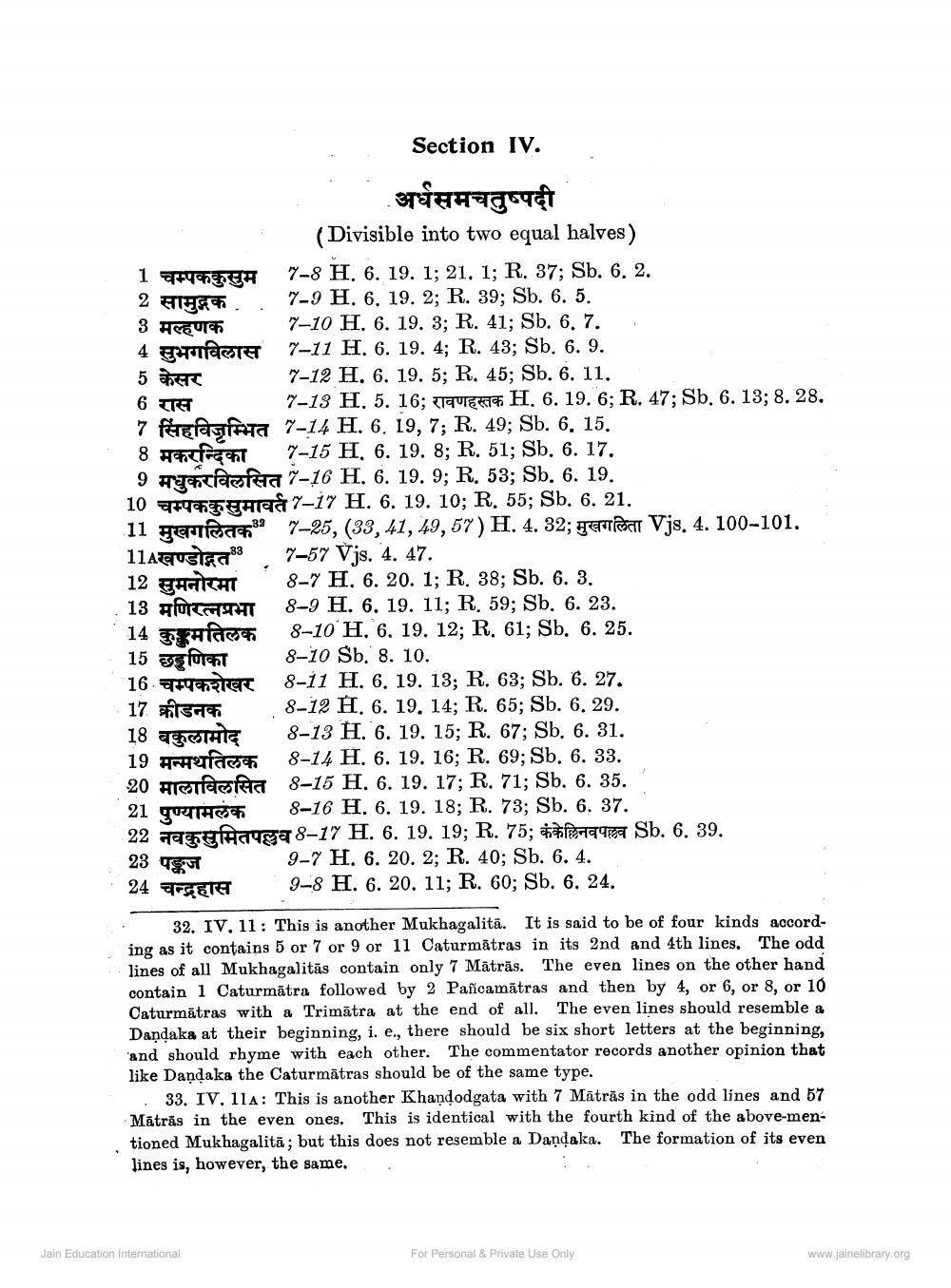________________
1 चम्पककुसुम
2 सामुद्रक
3 मल्हणक
7-8 H. 6. 19. 1; 21. 1; R. 37; Sb. 6. 2. 7-9 H. 6. 19. 2; R. 39; Sb. 6. 5. 7-10 H. 6. 19, 3; R. 41; Sb. 6, 7. 7-11 H. 6. 19. 4; R. 43; Sb. 6. 9. 7-12 H. 6. 19. 5; R. 45; Sb. 6. 11. 7-13 H. 5. 16;
6 रास
H. 6. 19. 6; R. 47; Sb. 6. 13; 8. 28. 7 feefagfora 7-14 H. 6. 19, 7; R. 49; Sb. 6, 15. 8 मकरन्दिका 7-15 H, 6. 19. 8; R. 51; Sb. 6. 17.
-
4 gerndarer
5 केसर
9 #gurasfera 7-16 H. 6. 19. 9; R, 53; Sb. 6. 19. 107-17 H. 6. 19. 10; R, 55; Sb. 6. 21.
32
11 मुखगलितक 725, (33, 41, 49, 67 ) H. 4. 92; मुखगलिता Vjs. 4. 100-101.
11Aखण्डोद्गत
12 सुमनोरमा
13 मणिरत्नप्रभा
Section IV.
. अर्धसमचतुष्पदी
(Divisible into two equal halves)
7-57 Vjs. 4. 47.
8-7 H. 6. 20. 1; R. 38; Sb. 6. 3. 8-9 H. 6, 19. 11; R, 59; Sb. 6. 23. 8-10 H. 6. 19. 12; R. 61; Sb. 6. 25. 8-10 Sb. 8. 10.
8-11 H. 6, 19. 13; R. 63; Sb. 6. 27. 17 क्रीडनक 8-12 H, 6. 19, 14; R. 65; Sb. 6, 29. 18 बकुलामोद 8-13 H. 6. 19. 15; R. 67; Sb. 6. 31. 19 मन्मथतिलक 8-14 H. 6. 19. 16; R. 69; Sb, 6. 33. 20 rufaa 8-15 H. 6. 19. 17; R. 71; Sb. 6. 35. 21 पुण्यामलंक 8-16 H. 6. 19. 18; R. 73; Sb. 6. 37. 22 नवकुसुमितपलब 8-17 H 6 19 19; R. 75; केहिनयपाल Sb. 6. 39. 23 पज 9-7 H. 6. 20. 2; R. 40; Sb. 6. 4. 9-8 H. 6. 20. 11; R. 60; Sb. 6. 24.
24 चन्द्रहास
14 कुङ्कुमतिलक
15 og forest 16 चम्पकशेखर
32. IV. 11: This is another Mukhagalita. It is said to be of four kinds according as it contains 5 or 7 or 9 or 11 Caturmatras in its 2nd and 4th lines. The odd lines of all Mukhagalitas contain only 7 Matras. The even lines on the other hand contain 1 Caturmatra followed by 2 Pañcamātras and then by 4, or 6, or 8, or 10 Caturmatras with a Trimatra at the end of all. The even lines should resemble a Dandaka at their beginning, i. e., there should be six short letters at the beginning, and should rhyme with each other. The commentator records another opinion that like Dandaka the Caturmatras should be of the same type.
Jain Education International
33. IV. 11A: This is another Khandodgata with 7 Matras in the odd lines and 57 Mātrās in the even ones. This is identical with the fourth kind of the above-mentioned Mukhagalită; but this does not resemble a Dandaka. The formation of its even lines is, however, the same.
For Personal & Private Use Only
www.jainelibrary.org




